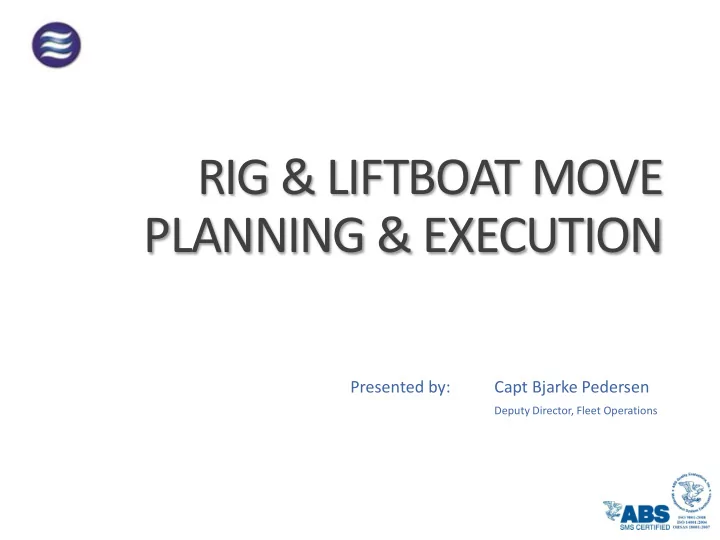

RIG & LIFTBOAT MOVE PLANNING & EXECUTION Name Title Presented by: Capt Bjarke Pedersen Deputy Director, Fleet Operations Company Name
Lessons Learned from Incidents Lessons Learned from other Jackup Incidents
Key Assessment Criteria & Information Teras Internal procedures in place for the Unit Specific Operations Manual Key details including dimensions, number of legs, weigh,. Jacking system, pre- load details, wind areas etc. Location Assessment / Site Specific Assessment Water depth, Metocean conditions, airgap seabed (topographic, debris, etc) and sub-seabed data (strength of soil) Operations Time of year & duration of proposed operations, nature of operations. Crane serviceable range, accommodation requirements Verified by Marine Warranty Surveyor (MWS) with Certificate of Approval.
Control Measures in place Conduct of Geophysical & Geotechnical Survey Suitability Checks Methods Rig Strong - Based on site specific metocean & soils data Enough - Within limited operating envelopes - Structural integrity checks Legs Long Enough - Subject to the following - Rig stated operating water depth - Sufficient height for harsh metocean - Leg penetration Location Hazards - Avoid overlapping old footprint where possible / Position - Avoid seabed debris - Hull is above extreme water level - Spudcan to platform / pile proximity - Hull / platform proximity afloat
Rig Strong Enough Bearing Capacity
Legs Long Enough Does it fit? Max predicted penetration Reserve of leg above jack- Water Depth house Air gap (min or per client) Air gap Water depth Leg penetration
Location Hazards Rapid spudcan penetration Uneven seabed Footprints Debris Pipelines & Cables Boulders Spudcan-pile interaction Buried / infilled channels
Location Hazards Footprints Uneven seabed Pipelines & Cables
Location Hazards Uneven Seabed Debris
Location Hazards Boulders Visible in bathymetry / debris survey Boulders
Location Hazards Spudcan-pile Interaction Safe distance from the existing leg structure Piled foundation structural integrity interaction
Location Hazards Buried / Infilled Channels Different penetration response Excessive penetration Eccentric loading
Rig Strong Enough Spudcan Penetration Responses
Rig Move Procedure
Approach Plan
Final Position
Side Profile
Teras Offshore Liftboat Simulation Training Manoeuvring & Bridge Resource Management Training
Lift Boat Simulation Training Centre (LSTC) 19 of 23
Lift Boat Simulation Training Centre (LSTC) Simulator assessment of candidates supported by feedback from other departments, e.g. Technical, Crewing, Operations and HSE. 20 of 23
Lift Boat Simulation Training Centre (LSTC) Scenarios designed based on Competency Requirements. Scenarios include environmental factors, i.e. wind, current, swell height. 21 of 23
Lift Boat Simulation Training Centre (LSTC) Visual aids to facilitate trainee’s learning. Trainer’s feedback and comments during and immediately after trainee’s session. 22 of 23
Recommend
More recommend